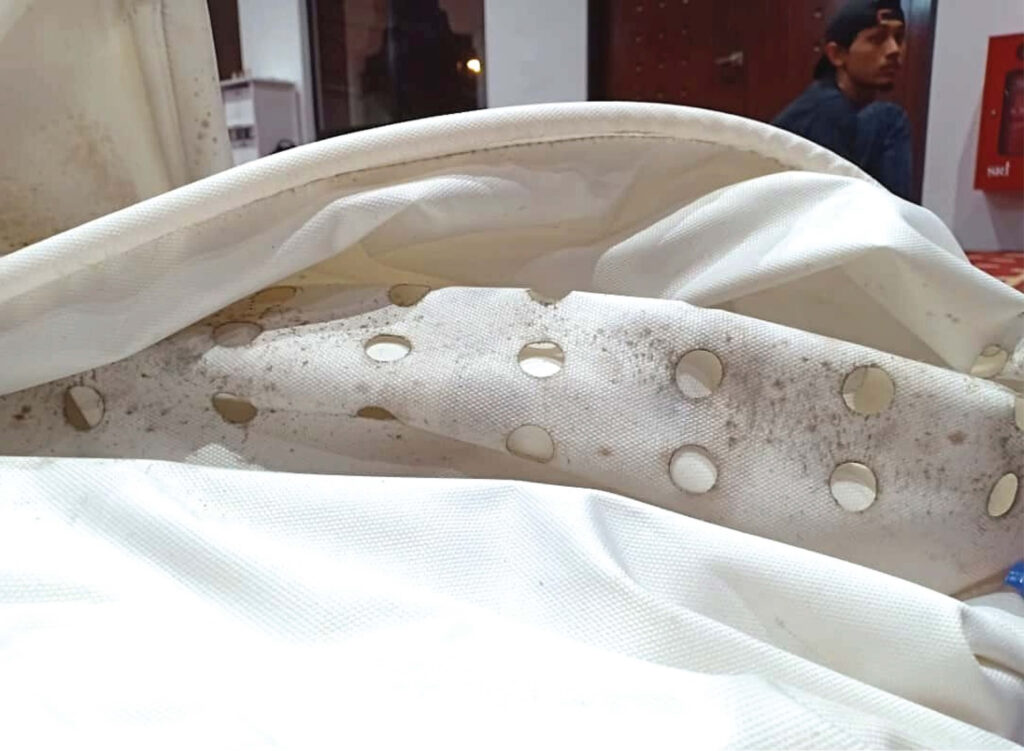Cleaning And Maintenance
Keeping it clean
All our ducting & diffusers are made from high quality and highly resistant materials without natural fibre additives. The material used is specified within the technical description of your order. If the diffuser/ducting is equipped with tyres, arcs or tensioning systems, these fixed components need to be taken out before washing.
Any maintenance must strictly follow the washing label symbols sewn into every section.
Legend for symbols

Machine wash at maximum temperature of 40°C. Normal mechanical action. Normal rinse. Normal spin cycle.

Light Mechanical Action. Rinse at falling temperature. Light spin. Gentle machine wash. Maximum temperature 40°C.

Hand wash only. Do not machine wash. Maximum temperature 40°C. Handle gently

do not bleach product

do not dry the product in a rotary drum drier

iron at a max. temperature of 110°C, use caution when steam ironing

do not iron product; steaming and steam processing is prohibited

Do not dry clean the product. Do not remove spots using organic solvents

The product is safe to dry clean using perchlorethylene and all solvents specified under the symbol F
Fabric Duct Cleaning: How often do I need to wash my fabric duct?
This is one of the most common questions we get. It’s also one of the most difficult to answer because it depends entirely upon the AHU system, the level of filtration, the cleanliness of the air in the immediate environment of the Fabric Ducting system(s), and the type of material and diffusers used.
There are a number of factors when considering your fabric duct maintenance. For instance, fabric ducts (often referred to as air socks) need washing for one of several reasons:
(1) The duct has become blocked with dust and is causing system inefficiency and loss of performance. This is rarer than you might think. It is commonly caused by poor filtration management in AHU systems using permeable fabric ducts with micro-perforations only. This duct will need turning inside out and vacuuming to remove most of the dust prior to washing.
(2) The duct has signs of dirt on the outside, and it is no longer aesthetic. This is dust from the room the fabric duct is mounted in. It can get entrained in the air pattern and settle on the duct, usually near the laser-cut perforations. There is not normally a loss of performance in this situation. The duct can be wiped down, vacuumed or removed and washed depending upon the internal level of dust build-up.
(3) Some applications have increased hygiene requirements and need regular cleaning. This is usually a food or cleanroom situation. In these cases, industrial duct cleaning is undertaken as a requirement of the hygiene systems within the organisation, not because of a lack of performance or visible dust deposits.


Washing procedure
1. Very dusty diffusers: unzip each section and carefully remove the fabric duct from the track, section by section. This minimises the weight gradually, reducing the stress on the track. Take it to a convenient place and vacuum it using a soft brush. Turn inside out and vacuum the inside.
2. Polyester Ducts: wash in a washing machine with industrial washing detergents (dosing as per supplier recommendation), at 40°C. We recommend spinning at 400 rpm and intensive rinsing. For heavily soiled ducts, this process can be repeated or a stronger detergent used. Use an adequate detergent for handwashing. Traditional diffusers are not machine washable. These can usually be effectively cleaned by vacuum cleaner, floor cloth or water stream.
3. Add disinfection into the wash, if required, as part of your hygiene process. The chemicals used for disinfection must not affect the fabric – see the washing symbols. Detergents dosing as per supplier’s recommendation.
4. Either drip dry the diffusers well after washing before installing, or install slightly damp and allow the supply air to dry the ducts. DO NOT TUMBLE DRY or in any other way heat the fabrics during drying above 40°C, as this may result in damage.
5. DO NOT STORE DAMP – mould can occur, and this damage is impossible to remove completely.

COPYRIGHT
© 2023 Prihoda Malaysia. All rights reserved.
